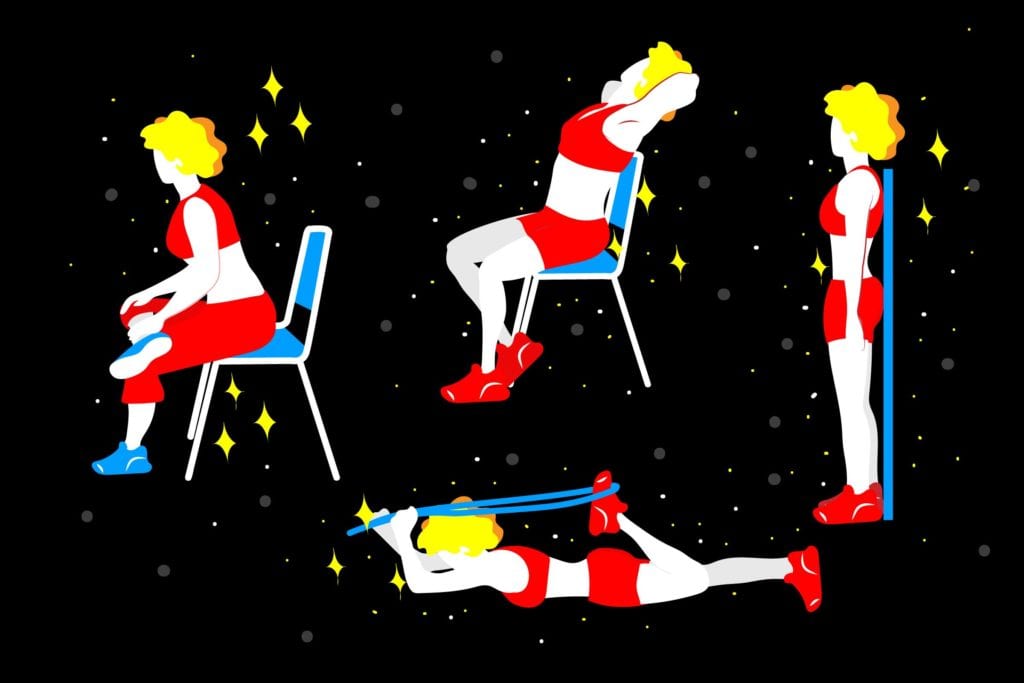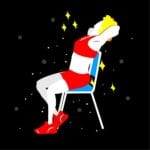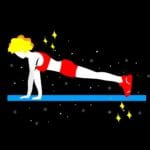

Back pain is typically one of those aches that worsens when you bend or walk and feels better when you rest or recline. That’s not the case with ankylosing spondylitis. This inflammatory disease causes pain and stiffness in your lower back and hips — especially in the morning or after prolonged periods of not moving. (Read more about the difference between inflammatory and mechanical back pain here.)
Here’s why your back hurts when you have ankylosing spondylitis (AS), and how stretching and exercise helps relieve symptoms.
How Ankylosing Spondylitis Affects Your Spine
Ankylosing spondylitis (AS) is a form of arthritis that causes inflammation in the joints in your spine, or vertebrae. As the disease progresses, it impacts the sacroiliac joints (which connect the base of your spine and your pelvis), and can lead to severe and chronic pain, stiffness, and discomfort in your lower back and hips.
Inflammation may also occur in the connective tissue in your spine where tendons and ligaments attach to bone (caused the entheses); in the cartilage between your breastbone and ribs; the back of your heel; as well as your hip and shoulder joints. (Here are other symptoms of ankylosing spondylitis to be aware of.)
In more severe cases of AS, new bone forms in the spine as part of the body’s attempt to heal from the inflammation. The extra bone bridges the gap between vertebrae, reducing flexibility in your back. Eventually, bone grows at the sides of the vertebrae, causing sections of the spine to fuse together and become immobile, which can reduce your ability to turn your head, stand up straight, or bend. Bony fusions can also stiffen your rib cage, making it tough to take deep breaths.
Less often, fusion of the spine can cause it to curve forward, resulting in a hunched-forward posture.
There’s no cure for ankylosing spondylitis, but treatments — including medication (such as non-steroidal anti-inflammatory drugs, or NSAIDS, and biologics) and physical therapy — can lessen pain and stiffness, and possibly slow the progression of the disease.
How Exercise Helps Ankylosing Spondylitis
Besides seeing your doctor regularly and following your treatment plan, staying active is probably the best thing you can do to manage your AS. “Physical therapy and exercise can help relieve pain, maintain flexibility, and improve mobility, posture, and strength,” says Pranjali Sathe, PT, DPT, an Ohio-based board certified orthopedic physical therapist. In fact, most people with AS say pain improves after exercise or activity.
The best time to exercise: when you wake up. “Morning stiffness is very common with AS,” explains Dr. Sathe, who is also certified in the McKenzie Method of Mechanical Diagnosis and Therapy. Start with flexibility and range-of-motion exercises, and continue to stay active and exercise throughout the day.
The types of exercises your doctor or physical therapist may recommend include:
Posture training: Practicing good posture techniques helps you avoid slouching forward so you reduce the amount of strain on your spine.
Flexibility exercises: Gentle range-of-motion and stretching exercises help keep the spine and other joints from getting stiff, improve mobility in your joints, and help keep your back flexible.
Deep-breathing exercises: The goal is to expand your chest so you can breathe better.
Strengthening exercises: Making your back and core muscles stronger can help maintain proper posture and keep your body stable. Strengthening back muscles also provides better support to bones and joints, which may reduce pain.
Balance exercises: “Loss of balance is seen in advanced AS,” says Dr. Sathe. Poor posture can make you less steady on your feet, which can increase your risk of falling when you walk.
Aquatic exercises: Water aerobics can help decrease joint pain and improve mobility.
Stretches Exercises to Help Ankylosing Spondylitis Pain
If you’re new to exercise, always talk to your doctor before starting. Your doctor or physical therapist can make sure the exercises are safe for you. Start slowly and move gently. And if any activity increases joint pain, and if pain continues for several days after exercise, it’s time to stop. Talk to your doctor about what pain is normal and when it’s a sign of something more serious.
The following stretches and exercises were recommended by Dr. Sathe, who is the author of the APTA’s “Physical Therapist’s Guide to Ankylosing Spondylitis.”


1. AS Exercise: Back Against a Wall
Maintains posture
- Stand against a wall, with your heels and buttocks touching the wall.
- Squeeze your shoulder blades together.
- Hold for 5 seconds, then relax. Repeat.


2. AS Exercise: Prone Lying
Improves posture
- Lie on your stomach.
- Slowly prop yourself up on your elbows so your chest is off the ground.
- If you’re able, straighten your arms.
- Hold for 10 to 20 seconds, then return to start position. Repeat.


3. AS Exercise: Seated Thoracic Extension
Stretches chest muscles
- Sit upright in a chair, with your feet flat on the floor.
- Place your hands behind your head for support, with your elbows out to the sides.
- Keeping your head still, slowly roll the top of your spine over the back of the chair.
- Hold for 5 to 10 seconds, then return to start position. Repeat.


4. AS Exercise: Quadricep Stretch
Stretches the front of your thigh
- Lie on your stomach.
- Loop a strap, belt, or sheet around the top of one foot.
- Gently pull the strap over your shoulder until you feel a stretch through the muscle.
- Hold for 10 to 20 seconds, then return to start position. Repeat on the other side.


5. AS Exercise: Seated Figure Four Stretch
Improves hip mobility
- Sit upright in a chair, with your feet flat on the floor.
- Lift your right leg and place your right foot on top of your left thigh, just above your knee.
- Keeping your spine as straight as possible, slowly hinge forward. For a deeper stretch, apply gentle pressure on the right thigh.
- Hold for 10 to 20 seconds, then return to start position. Repeat on the other side.


6. AS Exercise: Plank
Helps stabilize your core
- Lie on your stomach with your forearms on the floor and elbows directly below your shoulders.
- Tighten your stomach muscles and lift your hips off the floor.
- Squeeze your buttock muscles, and left your knees off the floor.
- Keep your body straight, without letting your pelvis sag toward the floor.
- Hold for 10 to 20 seconds, then return to start position. Repeat.





